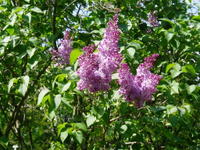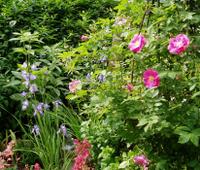There's no doubt that Nature has a mind of her own.
For the past few years, I've been encouraging and tending a natural garden on the easternmost lot of my property. I've fallen in love with the idea of nurturing a piece of land that is semi-wild (in contrast to my other gardens that tend to be highly cultivated). I want a garden where Nature dominates, where my efforts are rewarded but are secondary to the natural course of things.
In the Beginning ....
Within a week of purchasing my home, I discovered that the back lot was home to native plants, snakes, frogs, turtles, rabbits, skunks, birds, ants, and other critters.

Because the soil was relatively poor but dense and the area was in partial shade for most of the day, it had not turned into a jungle. Because it was a distance from the house and main yard, it had never been cultivated. So I decided that this piece of land would continue to provide a habitat for other creatures but I'd play with it a bit and see what came of my efforts.
Who Belongs Here Anyway?
I have always loved frogs and toads and so I'm consistently delighted to find them hopping around when I walk the land. To encourage their staying put, I set out low-to-the-ground water trays for them in protected areas. I worry when I don't see them.

I've banished all non-gardeners -- including pets and workmen who tramp on anything that's not human -- from the area.
Discovering the Native Plants
During my first Spring here (before I'd even moved into the house), I discovered masses of sweet violets carpeting large semi-shaded areas. I was smitten. Violets are so lovely in early May.

Later, I discovered a small clump of Ragged Robin in bloom. I loved them. I felt a need to protect and nurture them. And so I surrounded them with a simple, low, wire fence to keep them safe from foot traffic. Plus, I had noticed some wild rabbits hopping about and wondered if they would eat the Ragged Robin. Probably not but I wasn't about to chance it.

In June, when the Ragged Robin went to seed, I carefully scattered the seeds adjacent to where the mother plants were growing. I extended the wire fencing to define the new boundaries.
Just Wait and See
Now hooked on the idea of a wild garden, I continued to explore the current plot as the season progressed. I've been gardening for long enough to know that you need to wait-and-see in a garden that's new to you. It's hard but definitely worthwhile. And so I waited and scrutinized every piece of foliage on that piece of land.
I started reading gardening books about native plants and wild flowers that did well in New England, Zone 5. I sought and got advice from my friend, Sarah, whose gardens are magical. I bought seed.
As June progressed, I noticed a cluster of wild strawberries in a sunny area. More fencing installed!

Of course, there were lots of weeds and dandelions scattered about everywhere so I set myself to the task of uprooting them. I made a special pile of the weedy foliage for the rabbits. Fence guilt, I suppose.
It didn't take long to notice that they had no interest in the weeds or similar garden debris. Forget it! They wanted the strawberries and kept finding ways to out-maneuver my fencing. Clever critters. I admitted defeat and removed the fencing. Sharing is good, I reminded myself.....
Adding Texture to the Tapestry
I replaced dandelions with Hesperis for a late Spring background. I added mature plants, seedlings, and scattered a very large bag of fresh seeds that my friend, Sarah, donated from her garden.

I discovered a small group of Ox Eye Daisies at the periphery of the garden where the soil meets the tree line. I bought and scattered packets of seeds in the same area and in what I thought to be a similar micro-climate at the opposite side of the garden. I envisioned a happy oasis of cheerful daisies growing in large clusters on the north and south sides of the garden each June.

I cast down seeds of red corn poppies, hoping that they'd evolve into wild masses within the Summer garden. Think Monet...
I created a small oblong planting area for the Brown-eyed Susan seedlings that I hoped would eventually multiply and spread into a gorgeous wave that would move in the breezes of late Summer.

I transplanted wild Asters

and Goldenrod to finish off the garden year.

Fantasy Time
By July, I had a full-blown fantasy of a wild but idyllic garden tapestry. The plants would be happy and would prosper. The wildlings would spread like crazy and in late Spring/early Summer, I'd have multiple swathes of soft pastels, interwoven and stunning. Discreet paths would invite you to discover and enjoy these treasures.
Every Summer I'd munch on sweet, delicious wild strawberries. The rabbits and I would share the bounty.

In the Fall, the garden would shimmer as the tall Asters, Goldenrod, and wild grasses swayed in the breeze. The season would wind down slowly, then the entire garden would be covered in a blanket of snow, protecting the plants from the harsh Winter winds.
Welcome to Reality
In my mind's eye, the garden adheres to my idyllic fantasy. In reality, the garden does what it wants.
Every year is different. Some plants thrive while others founder. In years of abundant rain and snow, the garden does beautifully. In dry years the plants suffer and the insects take their toll. Some critters nibble away at the violet's foliage. I find tattered remains everywhere. The Brown-eyed Susans don't always get to flower. They are someone's dinner by July and struggle on as stumps with partially-chewed leaves. The asters have vacated the area. Who knows where they went? The original clump of Ox-eye Daisies returns every year but it has not multiplied by much. The Hesperis plants have done well but have not grown into the swathes that I imagined. I sometimes find a seedling growing far from the others. A loner, perhaps? The seeds that I sowed refused to germinate.
On the plus side, each year offers at least one heart-warming success. This year, the Ragged Robin were awesome! They had flourished and multiplied and offered an early June display that astounded me. I no longer scatter the seed. I let the wind take care of that task. Perhaps that's what's needed. Leave Nature alone.

The strawberries have taken over large patches of the center garden. There's enough for everyone! I've even seen bees working over the berries. Do yellow-jackets actually eat strawberries?
My biggest surprise this year was the discovery of large swathes of Celandine Poppies growing at the periphery, along the garden borders.

These shrub-like plants are exquisite. I did not plant them in this garden. I had planted the seeds in another shade garden where they did not grow. How they got to the wild garden and why they prefer this locale is a mystery. But it's a mystery that delights me.

Nature redefines this garden every year. She's much better at gardening than I am. How wonderful!















































